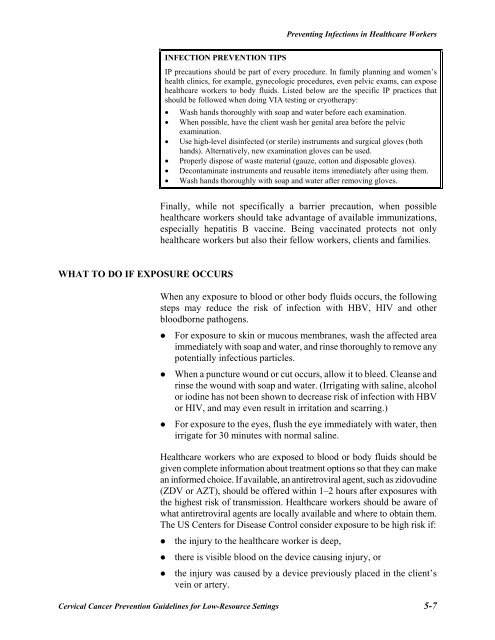Reference Manual - IARC Screening Group
Reference Manual - IARC Screening Group
Reference Manual - IARC Screening Group
Create successful ePaper yourself
Turn your PDF publications into a flip-book with our unique Google optimized e-Paper software.
Preventing Infections in Healthcare WorkersINFECTION PREVENTION TIPSIP precautions should be part of every procedure. In family planning and women’shealth clinics, for example, gynecologic procedures, even pelvic exams, can exposehealthcare workers to body fluids. Listed below are the specific IP practices thatshould be followed when doing VIA testing or cryotherapy:• Wash hands thoroughly with soap and water before each examination.• When possible, have the client wash her genital area before the pelvicexamination.• Use high-level disinfected (or sterile) instruments and surgical gloves (bothhands). Alternatively, new examination gloves can be used.• Properly dispose of waste material (gauze, cotton and disposable gloves).• Decontaminate instruments and reusable items immediately after using them.• Wash hands thoroughly with soap and water after removing gloves.Finally, while not specifically a barrier precaution, when possiblehealthcare workers should take advantage of available immunizations,especially hepatitis B vaccine. Being vaccinated protects not onlyhealthcare workers but also their fellow workers, clients and families.WHAT TO DO IF EXPOSURE OCCURSWhen any exposure to blood or other body fluids occurs, the followingsteps may reduce the risk of infection with HBV, HIV and otherbloodborne pathogens.• For exposure to skin or mucous membranes, wash the affected areaimmediately with soap and water, and rinse thoroughly to remove anypotentially infectious particles.• When a puncture wound or cut occurs, allow it to bleed. Cleanse andrinse the wound with soap and water. (Irrigating with saline, alcoholor iodine has not been shown to decrease risk of infection with HBVor HIV, and may even result in irritation and scarring.)• For exposure to the eyes, flush the eye immediately with water, thenirrigate for 30 minutes with normal saline.Healthcare workers who are exposed to blood or body fluids should begiven complete information about treatment options so that they can makean informed choice. If available, an antiretroviral agent, such as zidovudine(ZDV or AZT), should be offered within 1–2 hours after exposures withthe highest risk of transmission. Healthcare workers should be aware ofwhat antiretroviral agents are locally available and where to obtain them.The US Centers for Disease Control consider exposure to be high risk if:• the injury to the healthcare worker is deep,• there is visible blood on the device causing injury, or• the injury was caused by a device previously placed in the client’svein or artery.Cervical Cancer Prevention Guidelines for Low-Resource Settings 5-7
















